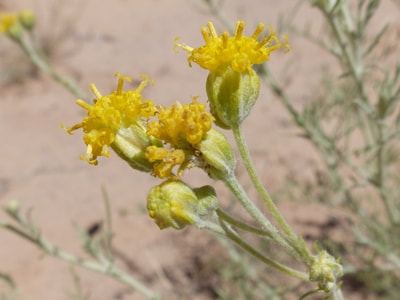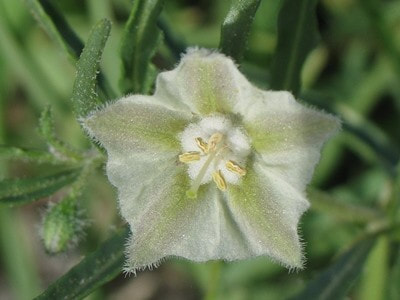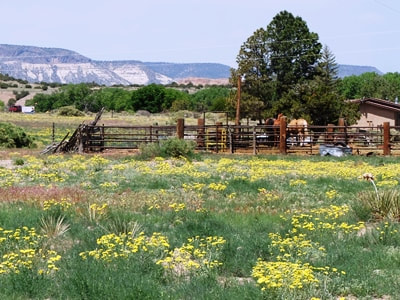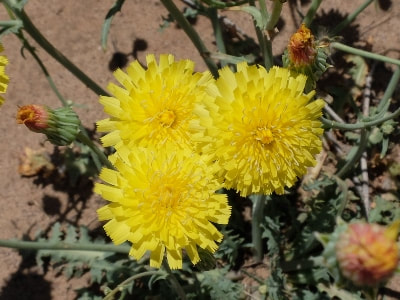|
The Bloom Blog Blooming this week in the environs of Abiquiú By Wildflowers of the Southern Rocky Mountains Found in dry, sandy, open areas Seen blooming in June on the Espinosa Trail, Abiquiu Fineleaf Hymenopappus is easily overlooked because it has no petal-like ray flowers and small flower heads. It is usually a woolly/hairy plant with stems branching from a rosette or mound of basal leaves. Leaves are twice-divided into narrow or thread-like leaflets which are sometimes covered in woolly hairs, giving a grey appearance. Tubular disk flowers have five lobes and range in color from very yellow to almost white. Thirteen varieties have been identified. This variety, cinerus, grows to 2½ feet high covered in dense white hair in a more rounded bushy form. Basal and stem leaflets are very finely divided. Flowers are less than ½" across and yellow. Traditionally, a poultice of the root with lard was applied to ease swellings, and a decoction of the root was taken as an emetic. The root was also used as a chewing gum, and the leaves were boiled and baked into bread. Source. If you are trying to identify a different flower then you can check what other flowers bloom this month. If you cannot identify a flower from the website, send a photo and where you took it to [email protected]. Read online for tips.
0 Comments
The Bloom Blog Blooming this week in the environs of Abiquiú By Wildflowers of the Southern Rocky Mountains Found in meadows, open conifer forests
Seen blooming in June by FS Road 137, Carson National Forest Larkspur grows to eighteen inches high with pale lavender to deep blue flowers, rarely white. The flowers have a long ‘spur’ to the rear of the flower which apparently resembles a Lark's foot structure giving it its common name. Leaves are deeply divided and found mostly on the lower part of the stem. All parts of the plant are toxic and poisonous to livestock, particularly when the plant is young. A blue dye can be made from the flowers, which has also been used as ink. Traditionally, native peoples have used the blue flowers for coloring arrows and other items, or for various ceremonies. Source. \ If you are trying to identify a different flower then you can check what other flowers bloom this month. If you cannot identify a flower from the website, send a photo and where you took it to [email protected]. Read online for tips. Greenleaf Five Eyes, Green False Nightshade,Chamaesaracha coronopus,Nightshade Family (Solanaceae)6/7/2024 The Bloom Blog Blooming this week in the environs of Abiquiú By Wildflowers of the Southern Rocky Mountains Found in dry, sandy areas, roadsides
Seen blooming in June by Hwy 554 near the Forest Service sign Very big names for a plant growing only a few inches high. Greenleaf Five Eyes is a member of the Nightshade family which includes tomatillos and tomatoes and which the flowers strongly resemble. It can grow to 18 inches high with long, narrow, lobed leaves. Flowers are greenish-white with five fused petals and five stamens, about ½ inch across. There are five hairy pillow-like bumps in the center which are presumably the ‘five eyes’. The fruit matures to a whitish berry about ¼ inch across. Chama in the scientific name comes from the Greek word for false. The name Chama, as in the Rio Chama, comes from an Indian pueblo called Tsama near Abiquiu along the north side of the river near its confluence with the El Rito creek. In the Tewa language, Tsama is defined as “wrestling place” or “fighting around place”. Source. The Navajo used the plant for swellings and in cases of drowning. Source. If you are trying to identify a different flower then you can check what other flowers bloom this month. If you cannot identify a flower from the website, send a photo and where you took it to [email protected]. Read online for tips. Sowthistle Desert Dandelion, Yellow Saucers,Malacothrix sonchoides,Sunflower Family (Asteraceae)5/31/2024 The Bloom Blog Blooming this week in the environs of Abiquiú By Wildflowers of the Southern Rocky Mountains Found in dry, sandy areas
Seen blooming in May around Mamacita’s, Hwy 554 In the fields around Mamacita’s there is a super bloom of Sowthistle Desert Dandelions happening. Thousands of showy yellow flowers are brightening the smoky landscape. In the 12 years I have lived here I have never seen this before; must be right moisture at the right time. There is also an abundance of bright orange Globemallow blooming along the highways. Sowthistle Desert Dandelions grow to 14 inches high with smooth, leaning, twisted, branched stems and short, fleshy, lobed leaves growing in a rosette. Flower heads are dandelion-like with only ray flowers and are about one inch across. Individual petals are toothed at the tip. The Navajo used the plant for vomiting; unspecified whether to induce or cure. Source. If you are trying to identify a different flower then you can check what other flowers bloom this month. If you cannot identify a flower from the website, send a photo and where you took it to [email protected]. Read online for tips. The Bloom Blog Blooming this week in the environs of Abiquiú By Wildflowers of the Southern Rocky Mountain By Marilyn Phillips
Found in dry, sandy, gravelly areas, in piñon-juniper woodlands Seen blooming in May off FS Road 23, Carson National Forest We have several species of Penstemon growing in our area. Some also have the common name of Beardtongue because of the long, hairy tongue that sticks out from the throat of the flower. This Penstemon grows to 14 inches high with many narrow lance-shaped leaves. Flowers and buds are very sticky and hairy and grow on one side of the stem. The flowers are lavender to violet with dark purple nectar guide lines. They are about ½ inch long with a wide, densely hairy throat and a curved tongue covered in yellow hairs extending from the throat. Traditionally the plant was used as an emetic and lotion to purify a newborn infant before nursing and a cold, compound infusion of plant was taken for headache and sore throat. Source. If you are trying to identify a different flower then you can check what other flowers bloom this month. If you cannot identify a flower from the website, send a photo and where you took it to [email protected]. Read online for tips. |
AuthorI am Marilyn Phillips, a native of England, whose love of nature and the outdoors from childhood brought me by a circuitous route to Crested Butte, Colorado in 1993 and 16 years later to northern New Mexico. My exploration of the many trails in these areas, my interest in wildflowers and photography, and career in computer system design came together in this creation. If you have any corrections, comments or questions, please contact me by email. Archives
September 2025
Categoriescopyright © 2020
|








 RSS Feed
RSS Feed